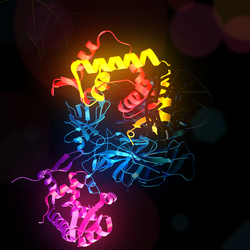Our website is made possible by displaying online advertisements to our visitors.
Please consider supporting us by disabling your ad blocker.
FOXP3
FOXP3 (forkhead box P3), also known as scurfin, is a protein involved in immune system responses.[5] A member of the FOX protein family, FOXP3 appears to function as a master regulator of the regulatory pathway in the development and function of regulatory T cells.[6][7][8] Regulatory T cells generally turn the immune response down. In cancer, an excess of regulatory T cell activity can prevent the immune system from destroying cancer cells. In autoimmune disease, a deficiency of regulatory T cell activity can allow other autoimmune cells to attack the body's own tissues.[9][10]
While the precise control mechanism has not yet been established, FOX proteins belong to the forkhead/winged-helix family of transcriptional regulators and are presumed to exert control via similar DNA binding interactions during transcription. In regulatory T cell model systems, the FOXP3 transcription factor occupies the promoters for genes involved in regulatory T-cell function, and may inhibit transcription of key genes following stimulation of T cell receptors.[11]
- ^ a b c GRCh38: Ensembl release 89: ENSG00000049768 – Ensembl, May 2017
- ^ a b c GRCm38: Ensembl release 89: ENSMUSG00000039521 – Ensembl, May 2017
- ^ "Human PubMed Reference:". National Center for Biotechnology Information, U.S. National Library of Medicine.
- ^ "Mouse PubMed Reference:". National Center for Biotechnology Information, U.S. National Library of Medicine.
- ^ Brunkow ME, Jeffery EW, Hjerrild KA, Paeper B, Clark LB, Yasayko SA, Wilkinson JE, Galas D, Ziegler SF, Ramsdell F (January 2001). "Disruption of a new forkhead/winged-helix protein, scurfin, results in the fatal lymphoproliferative disorder of the scurfy mouse". Nature Genetics. 27 (1): 68–73. doi:10.1038/83784. PMID 11138001. S2CID 13389419.
- ^ Hori S, Nomura T, Sakaguchi S (February 2003). "Control of regulatory T cell development by the transcription factor Foxp3". Science. 299 (5609): 1057–61. Bibcode:2003Sci...299.1057H. doi:10.1126/science.1079490. PMID 12522256. S2CID 9697928.
- ^ Fontenot JD, Gavin MA, Rudensky AY (April 2003). "Foxp3 programs the development and function of CD4+CD25+ regulatory T cells". Nature Immunology. 4 (4): 330–6. doi:10.1038/ni904. PMID 12612578. S2CID 3343021.
- ^ Fontenot JD, Rasmussen JP, Williams LM, Dooley JL, Farr AG, Rudensky AY (March 2005). "Regulatory T cell lineage specification by the forkhead transcription factor foxp3". Immunity. 22 (3): 329–41. doi:10.1016/j.immuni.2005.01.016. PMID 15780990.
- ^ Josefowicz SZ, Lu LF, Rudensky AY (January 2012). "Regulatory T cells: mechanisms of differentiation and function". Annual Review of Immunology. 30 (January): 531–64. doi:10.1146/annurev.immunol.25.022106.141623. PMC 6066374. PMID 22224781.
- ^ Zhang L, Zhao Y (June 2007). "The regulation of Foxp3 expression in regulatory CD4(+)CD25(+)T cells: multiple pathways on the road". Journal of Cellular Physiology. 211 (3): 590–7. doi:10.1002/jcp.21001. PMID 17311282.
- ^ Marson A, Kretschmer K, Frampton GM, Jacobsen ES, Polansky JK, MacIsaac KD, Levine SS, Fraenkel E, von Boehmer H, Young RA (February 2007). "Foxp3 occupancy and regulation of key target genes during T-cell stimulation". Nature. 445 (7130): 931–5. Bibcode:2007Natur.445..931M. doi:10.1038/nature05478. PMC 3008159. PMID 17237765.
Previous Page Next Page









